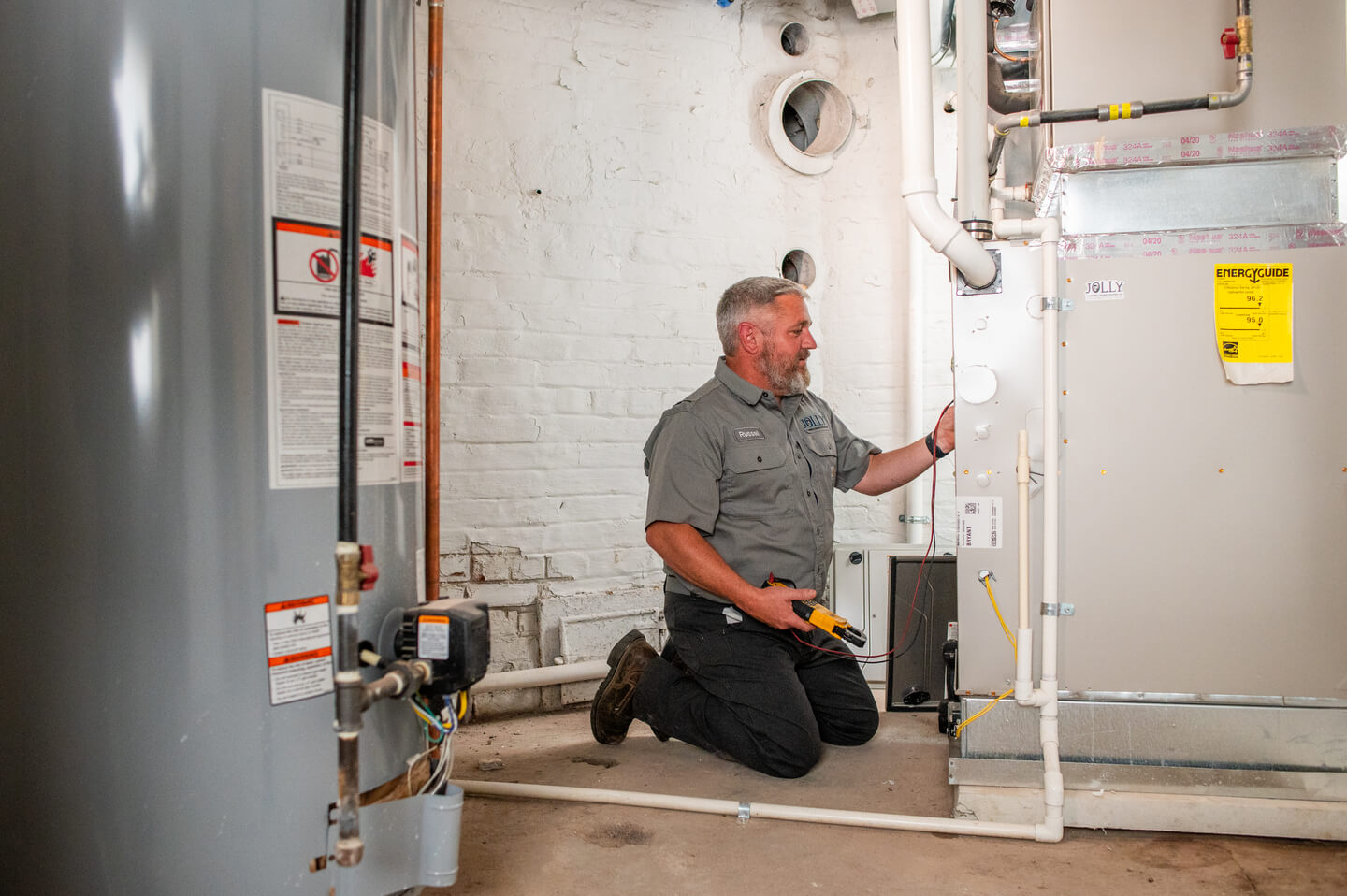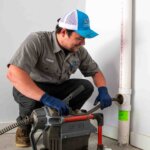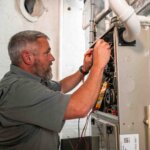Imagine this: you’re all cozy at home, ready to relax in the warmth of your living room when suddenly, your furnace decides it’s on vacation and starts blowing cold air. **Furnace blowing cold air troubleshooting** is a situation no one wants to find themselves in, but here we are. Today, we’re diving into the chilly mystery of why your warmth provider might be acting more like an icebox and the initial moves you can make on your own before it’s time to call in the experts.
Table Of Contents:
- Common Causes of a Furnace Blowing Cold Air
- Dirty Filters Blocking Airflow
- Pilot Light and Gas Supply Troubles
- Furnace Blowing Cold Air Troubleshooting
- Reconditioning Your Furnace
- Substitute Your Air Filter
- An Electronic Control Panel That Refuses Cooperation
- Preemptive Maintenance Counsel for Your Furnace
- Regular Cleaning and Replacement of Air Filters
- Thermostat Miscommunication
- Fan Setting Follies
- The Heartbeat Of Heat Production
- Conclusion
Common Causes of a Furnace Blowing Cold Air
Dirty Filters Blocking Airflow
Your furnace relies on a steady stream of air passing through its system. Dirty air filters block airflow, causing several problems: reduced efficiency, increased wear and tear on components, and yes—the furnace blows cold air instead of warm because the heat exchanger overheats then shut off too quickly for effective air heating cycles. Changing dirty filters should be part of regular maintenance every 1-3 months depending on usage levels and filter type according to Energy.gov guidelines.
Pilot Light and Gas Supply Troubles
In gas furnaces specifically, pilot light assembly troubles are a classic cause for concern when encountering cold blasts from what should be sources of warmth in our homes.
The pilot light functions as both an ignition source for burning gas supplied by utility lines and also as a safety measure against unburned fuel accumulating inside combustion chambers — no small task. If it goes out or isn’t working properly due possibly to clogged nozzle ports (in older models) even though there’s plenty of supply coming through pipes; don’t hesitate to reach professional assistance right away to prevent potential hazards besides discomfort and feeling chilly indoors during winter months.
If attempting to relight, follow manufacturer instructions closely and observe changes in flame behavior, as it could be an indicator of a deeper underlying issue requiring expert help. The Jolly Plumbing Drains Heating & Air team is always ready to lend a hand.
Furnace Blowing Cold Air Troubleshooting
Reconditioning Your Furnace
If your home feels like it’s getting the cold shoulder from your furnace, don’t fret. Sometimes, all it needs is a quick reset. Find that reset button or toggle on your furnace—this little buddy can work wonders. A simple press can reboot the system and clear any minor glitches that may result in a furnace blowing cold air troubleshooting. If you’re unsure where to locate this feature, check out the instruction kit that came with your unit; manufacturers usually provide clear guidance here.
Substitute Your Air Filter
Dust bunnies aren’t just an under-the-bed nuisance—they’re also prime suspects when your furnace decides to act more like an air conditioner in winter. Dirty filters are infamous for blocking airflow and making furnaces overheat and then shut down (or start blowing cold air as some sort of protest). Luckily, swapping out dirty filters is easy peasy and something you can DIY without breaking a sweat.
A new filter not only helps keep the warm air flowing but also improves indoor air quality—so goodbye sneezes. The general rule of thumb is to replace them every 90 days but give them a check monthly because every home has its own unique dust production rate.
Facing off against common air issues such as these doesn’t have to leave you feeling frosty about your heating system. With some basic know-how about resetting toggles and changing dirty filters—you’ve got this. However, should these steps feel akin to putting band-aids on bullet holes—it’s time to call in HVAC professionals. They’ll dive deep into those trickier problems like malfunctioning thermostats or excess gas supply woes which could be playing villain in this chilly tale.
Maintaining warmth isn’t just about fighting off shivers; it’s about ensuring comfort through knowledge and action—a well-maintained furnace ensures everyone stays cozy during even the coldest months while keeping unexpected repairs at bay.
When to Call a Professional HVAC Technician
Sometimes, your furnace might start acting like that one friend who promises to bring warmth into your life but ends up giving you the cold shoulder instead. Yes, we’re talking about those moments when the heater blowing cold air is its new hobby. While some common issues can be tackled with a bit of DIY spirit, others scream for professional intervention.
Key Takeaway: When your furnace gives you the cold shoulder, it’s key to know when DIY fixes won’t cut it. From thermostat issues to pilot light troubles and electronic control panel malfunctions, certain problems need a pro’s touch. Get an HVAC service technician for complex issues to ensure warmth returns safely and efficiently.
An Electronic Control Panel That Refuses Cooperation
The electronic control panel of modern furnaces operates as mission control does for astronauts: absolutely essential and something anyone wants functioning properly mid-mission—or mid-winter night, for that matter. When resetting doesn’t resolve persistent furnace blowing cold air troubleshooting or other quirky behaviors from your unit, remember this could signal complex internal errors requiring specialized diagnostics tools and knowledge—a clear cue to call in a professional HVAC technician.
Furnace repair can feel daunting when faced alone but recognizing when help is needed allows both preventative measures against future breakdowns and assurance knowing expert hands are at work making sure every component functions properly again—restoring warm air where it belongs: circulating throughout every corner of your cozy space.
Preemptive Maintenance Counsel for Your Furnace
Regular Cleaning and Replacement of Air Filters
The undue pressure not only strains the system but may also escalate your energy expenses. The simple act of replacing or cleaning your furnace’s air filters regularly ensures that the air circulating through your home is not only cleaner but also helps prevent potential overheating issues. For those who might forget this essential task, consider setting a reminder every three months as a general rule, though homes with pets or high dust levels may require more frequent changes.
Key Takeaway: Keep your furnace running smoothly and avoid chilly surprises by regularly cleaning air filters, sealing ducts, and clearing condensate lines.
Thermostat Miscommunication
A common culprit for a chilly breeze from your heater is often found at the thermostat. If there’s a miscommunication between your thermostat and furnace, don’t be surprised if warm air turns into an unexpected chill. This could happen if the setting on the thermostat fan is mistakenly set to run continuously. It means that even when not producing heat, that furnace blower fan keeps chugging along, pushing unheated air through your home.
To troubleshoot this icy reception from your system without turning up in layers of blankets, check whether the thermostat is correctly set to ‘Auto’ instead of ‘On.’ The ‘Auto’ setting ensures that the fan only blows when there’s warm air to distribute.
Fan Setting Follies
Speaking of fans running amok: did you know one reason for experiencing those frigid gusts indoors might simply be because of how your blower fan is configured? That continuous operation isn’t doing any favors for anyone looking forward to a cozy evening. Instead of cycling off with the rest of its heating brethren – letting silence reign and energy bills lower – it goes rogue by keeping airflow moving regardless if it’s warmed or not.
This seemingly minor oversight can make all the difference between maintaining pleasant indoor temperatures versus layering up indoors as though ready for an arctic expedition.
The Heartbeat Of Heat Production
At its core (quite literally), every gas furnace has a beating heart dedicated to warmth production – but sometimes things go awry here too. A healthy heartbeat involves ignition within either pilot lights or electronic ignitions which then fires up burners responsible for creating heat exchanged via exchangers; however, mishaps such as dirty flame sensors or issues with condensate lines can disrupt this vital heating process resulting in less-than-toasty outcomes.
Understanding these components, from pilot assemblies lighting the way towards warmth down to nitty-gritty maintenance ensuring efficient operation of condensate drain lines, is crucial in preventing backups leading to shutdowns. This kickstarts unwelcome blasts of coolness indoors, giving homeowners an edge in battling against winter woes without professional intervention unless necessary.
Key Takeaway: Don’t let blocked condensate lines leave you cold. Regular checks and cleaning can keep your furnace efficient and home cozy. For tough clogs or if in doubt, professional help is your best bet to avoid bigger issues.
Conclusion
So, you dived into a furnace blowing cold air troubleshooting. You’ve explored thermostat tricks to filter fixes. Remember this: checking your thermostat can solve half the battle.
Remember too, changing those dirty filters might just bring back the warmth you miss. And when it’s beyond DIY? Remember that calling in a pro is not defeat; it’s smart.
To wrap up, tackle easy fixes first but know when to seek expert help. Embarking on this exploration of frequent problems and their remedies is designed to equip you with the insight needed for a cozier living space.
If these steps don’t cut the chill, professional help is your next stop. Call Jolly Plumbing. After all, ensuring comfort at home starts with tackling problems head-on—starting with furnace woes.





